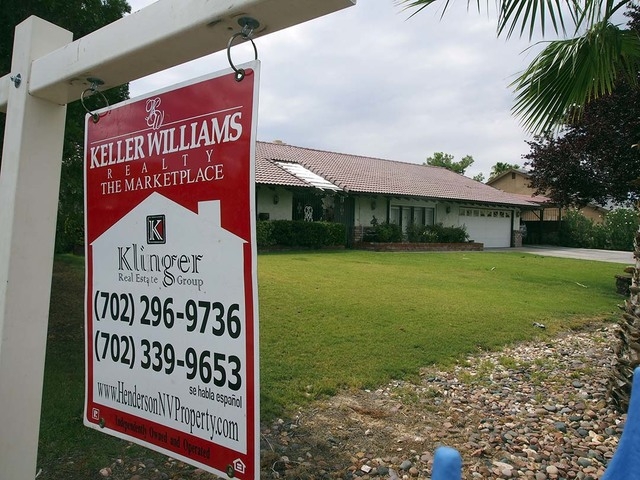Host of data show Nevada housing pushing toward normalcy
Nevada’s housing markets continued their slow slog toward normalcy in the first quarter, as distressed sales and investor activity declined.
That’s according to a Thursday report from California research firm RealtyTrac.
RealtyTrac’s analysts found that distressed sales, including auctions, short sales and bank repossessions, made up 18.4 percent of Nevada home sales from January through March. That was down from 28 percent in the same period of 2014.
A big chunk of the drop came from bank repossessions. Bank-owned sales were 5.6 percent of the market, down from 11.5 percent year over year.
Nationwide, 7.2 percent of sales were bank-owned, compared with 12.9 percent in 2014’s first quarter. Add up all distressed sales, and they were 14.5 percent of the U.S. market, down from 21.4 percent.
The numbers reflect what local experts say they’re seeing as well.
An April 8 report from the Greater Las Vegas Association of Realtors showed that bank-owned sales made up 9.3 percent of the market in March, down from 11.7 percent in March 2014. Cash sales, which indicate investor activity, were 32.4 percent of closings, down from 43.1 percent.
Distressed sales are tanking for two main reasons, RealtyTrac Vice President Daren Blomquist said.
First is big gains in equity: 28 percent of locals owe more than their home is worth, down from more than 70 percent in the bust. Where there’s equity, there’s less need to sell at a loss or get out fast.
Second, banks are still wrestling with what Blomquist called Nevada’s “dysfunctional” foreclosure process. Notices of default have yet to return to levels experienced before a spate of laws from 2011 to 2013 made it harder to foreclose.
With fewer foreclosure bargains, investors pared purchases. All types of investor sales fell to 42.4 percent statewide, compared with 44.9 percent in the first quarter of 2014. Nationally, investor activity increased, making up 36.8 percent of the market. That was up from 31.4 percent a year earlier.
Institutional-investor sales took an especially big dive. Large Wall Street hedge funds were behind just 2 percent of Nevada’s closings, down from 11.1 percent a year ago and a 10th of the 2012 peak of 20 percent. The nationwide share was 3.4 percent, compared with 6.2 percent a year earlier.
With prices on the rise, investing doesn’t make as much sense, Blomquist said.
The median, local single-family home price in March was $205,000, nearly double the recession-era low of $118,000. Meanwhile, median fair-market rents in Las Vegas have slipped in the last year.
“The numbers just don’t make as much sense for investors,” Blomquist said. “They realize maybe the Las Vegas market is a bit saturated with rentals, and there’s not as much opportunity to buy going forward.”
The decline in institutional investors is actually what you want to see, Blomquist said. Their 2 percent share is back to what were likely pre-bust levels, and is probably the typical portion in a healthy market.
The question is whether there are enough traditional buyers right now to pick up their slack.
“This market is transitioning from an investor-driven one to one that needs to become more owner-occupier-driven,” Blomquist said. “Are owner-occupiers gonna step up and not only be able to afford and qualify for a home, but have the confidence to buy? So far, our data (have) not shown a clear indication that they will.”
But Keith Lynam, president of the Greater Las Vegas Association of Realtors, said he believes traditional buyers are ready to move. He cited the association’s March numbers, which showed that single-family home sales spiked 37.8 percent from February to March — the largest gain for the period since 2006.
“We’re seeing a lot of people who were getting beat out on deals by investors starting to come back. They’re saying, ‘Hey, we lost out a year ago. What’s it like now?’ ” he said.
Don’t expect any major changes in market conditions through 2015: Price appreciation should drop slightly from its current 8 percent, and sales volume could weaken slightly as investors continue to sit out the market, Blomquist said.
“At the end of the day, I think it’s probably a good thing that we’re not seeing another bubble forming, but of course, that’s not good for people who are still underwater,” he said.
Contact Jennifer Robison at jrobison@reviewjournal.com. Find @J_Robison1 on Twitter.

















